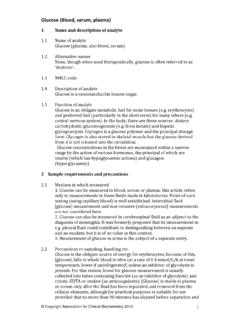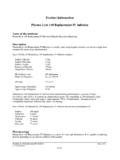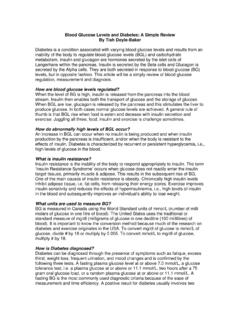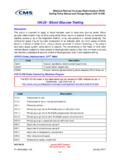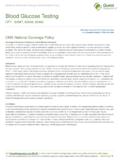Transcription of ABM Clinical Protocol #1: Guidelines for Blood Glucose ...
1 BREASTFEEDING MEDICINE. Volume 9, Number 4, 2014 ABM Protocol Mary Ann Liebert, Inc. DOI: ABM Clinical Protocol #1: Guidelines for Blood Glucose Monitoring and Treatment of Hypoglycemia in Term and Late-Preterm Neonates, Revised 2014. Nancy Wight,1,2 Kathleen A. Marinelli,3,4 and The Academy of Breastfeeding Medicine A central goal of The Academy of Breastfeeding Medicine is the development of Clinical protocols for managing common medical problems that may impact breastfeeding success. These protocols serve only as Guidelines for the care of breastfeeding mothers and infants and do not delineate an exclusive course of treatment or serve as standards of medical care. Variations in treatment may be appropriate according to the needs of an individual patient. Purpose Blood Glucose concentrations do develop secondary to pro- longed intervals (> 8 hours) between breastfeeding, a marked T o provide guidance in the first hours/days of life to: ketogenic response occurs.
2 The enhanced capability of the neonatal brain to utilize ketone bodies provides Glucose -sparing Prevent clinically significant hypoglycemia in infants fuel to the brain, protecting neurological ,7 9 The Appropriately monitor Blood Glucose levels in at-risk compensatory provision of alternate fuels constitutes a normal term and late-preterm infants adaptive response to transiently low nutrient intake during the Manage documented hypoglycemia in infants establishment of breastfeeding,3,10 resulting in most breastfed Establish and preserve maternal milk supply during infants tolerating lower plasma Glucose levels without any sig- medically necessary supplementation for hypoglycemia nificant Clinical manifestations or or during separation of mother and baby No studies have shown that treating transiently low Blood Glucose levels results in better short-term or long-term outcomes Background compared with no treatment, and in fact there is no evidence at all that hypoglycemic infants with no Clinical signs benefit from Physiology ,12 Increases in neurodevelopmental abnormalities The term hypoglycemia'' refers to a low Blood Glucose have been found in infants who have hypoglycemia associated concentration.
3 Clinically significant neonatal hypoglycemia with abnormal Clinical signs, especially those with severe, per- reflects an imbalance between the supply and utilization of sistent hyperinsulinemic 16 Rozance and Glucose and alternative fuels and may result from several dis- Hay17 have delineated the conditions that should be present turbed regulatory Transient hypoglycemia in the before considering that long-term neurologic impairment might first hours after birth is common, occurring in almost all mam- be related to neonatal hypoglycemia. Transient, single, brief malian newborns. In healthy, term human infants, even if early periods of hypoglycemia are unlikely to cause permanent enteral feeding is withheld, this phenomenon is self-limited, neurologic 21 Therefore, the monitoring of Blood without Clinical signs, and considered to be part of adaptation to Glucose concentrations in healthy, term, appropriately grown postnatallife,asglucoselevelsspontaneous lyrisewithinthefirst neonates is unnecessary and potentially harmful to parental well- 24 hours after birth (for some, it is even longer but still physio- being and the successful establishment of 23.)
4 Logical).2 6 Most neonates compensate for this physiological''. Definition of hypoglycemia low Blood Glucose with endogenous fuel production through gluconeogenesis, glycogenolysis, and ketogenesis, collectively The definition of hypoglycemia in the newborn infant called counter-regulation.'' Eveninthose situationswhere low has remained controversial because of a lack of significant 1. San Diego Neonatology, Inc., San Diego, California. 2. Sharp HealthCare Lactation Services, Sharp Mary Birch Hospital for Women and Newborns, San Diego, California. 3. Division of Neonatology and The Connecticut Human Milk Research Center, Connecticut Children's Medical Center, Hartford, Connecticut. 4. University of Connecticut School of Medicine, Farmington, Connecticut. 173. 174 ABM Protocol . Table 1. Population Low Thresholds: vidual patient. Rather, it is characterized by a value(s) that is plasma Glucose Level40 unique to each individual and varies with both their state of physiologic maturity and the influence of pathology Hour(s) after 5th percentile plasma birth Glucose level A meta-analysis of studies published from 1986 to 1994.
5 1 2 (nadir) 28 mg/dL ( mmol/L) looked at low plasma Glucose thresholds in term healthy 3 47 40 mg/dL ( ) newborns who were mostly mixed fed (breastfed and for- 48 72 48 mg/dL ( mmol/L) mula-fed) or formula-fed. It presented statistical ranges of low thresholds for plasma Glucose level based on hours after birth in healthy term infants (Table 1).40 The authors spe- correlation among plasma Glucose concentration, Clinical cifically noted that given the known lower plasma glu- signs, and long-term ,24,25 An expert panel con- cose levels in healthy term breastfed infants as compared vened in 2008 by the National Institutes of Health with formula-fed infants, the low thresholds for exclusively concluded that there has been no substantial evidence-based breastfed infants might even be lower. Table 1 gives rec- progress in defining what constitutes clinically important ommendations for this timed threshold approach. neonatal hypoglycemia, particularly regarding how it relates This information is translated into Guidelines for Clinical in- to brain Multiple reviews have concluded that there tervention by the operational treatment guidance of Cornblath is no specific plasma or Blood Glucose concentration or du- et As they stated, an operational threshold is that concen- ration of low Blood Glucose level that can be linked to either tration of plasma or whole Blood Glucose at which clinicians Clinical signs or permanent neurologic ,25,27 In ad- should consider intervention, based on the evidence currently dition, Blood Glucose test results vary enormously with the available in the literature (Table 2).
6 It needs to be underscored source of the Blood sample, the assay method, and whether that the therapeutic objective (45 mg/dL [ mmol/L]) is dif- whole Blood , plasma , or serum Glucose concentration is de- ferent from the operational threshold for intervention (36 mg/dL. termined. plasma or serum Glucose concentrations are 10 15% [ mmol/L]), which is different from the population low higher than in whole ,29 thresholds in normal babies with no Clinical signs or risk Breastfed, formula-fed, and mixed-fed infants follow the factors who do not need to be treated (Table 1). The higher samepatternofglucosevalues,withaninitial fallinglucoselevel therapeutic goal was chosen to include a significant margin of over the first 2 hours of life, followed by a gradual rise in Glucose safety in the absence of data evaluating the correlation be- level over the next 96 hours, whether fed or ,5,6 Artificially tween Glucose levels in this range and long-term outcome in fedinfantstendtohaveslightlyhigherlevels ofglucoseandlower full-term levels of ketone bodies than breastfed ,5,18,30 32 Given this information, it is clear that routine monitoring The incidence of hypoglycemia'' varies with the defi- of Blood Glucose in healthy term infants is not only unnec- ,34 Many authors have suggested numeric defini- essary, but is instead potentially harmful to the establish- tions of hypoglycemia, usually between 30 and 50 mg/dL ment of a healthy mother infant relationship and successful ( mmol/L)
7 And varying by postnatal ,5,18,24,26,33,35 38 breastfeeding ,20,22,23,41,42 This recommendation There is no scientific justification for the value of < 47 mg/dL has been supported by the World Health Organization,18 the ( mmol/L) that has been adopted by some ,25 27,39 American Academy of Pediatrics,1,41 the National In- Cornblath et summarized the problem as follows: stitutes of Health,26 and the National Childbirth Trust of the United These organizations all conclude that (1). Significant hypoglycemia is not and cannot be defined as a early and exclusive breastfeeding is safe to meet the nutri- single number that can be applied universally to every indi- tional needs of healthy term infants and that (2) healthy term Table 2. Operational Thresholds for Treatment of plasma Glucose Levels10. Infant Plan/PGL Treatment Infant with Clinical If < 45 mg/dL Clinical interventions to increase signs ( mmol/L) Blood Glucose concentration Infants with Initiate Glucose monitoring as Clinical interventions to increase Blood Glucose risk factorsa soon as possible after birth, concentration: at very low Glucose concentration within 2 3 hours after birth (20 25 mg/dL, mmol/L), intravenous and before feeding, or at any Glucose infusion to raise plasma Glucose levels time there are abnormal signs.
8 To > 45 mg/dL ( mmol/L) is indicated. If plasma Glucose concentration is < 36 mg/dL ( mmol/L), close surveillance should be maintained. Intervention is recommended if plasma Glucose remains below this level, does not increase after a feed, or if abnormal Clinical signs develop. PGL, plasma Glucose level. a See Table 3. ABM Protocol 175. infants do not develop clinically significant hypoglycemia Table 3. At-Risk Infants for Whom Routine simply as a result of a time-limited duration of underfeeding. Monitoring of Blood Glucose Is Indicated Testing methods Small for gestational age: < 10th percentile for weight commonly cited in the United States; < 2nd percentile Bedside Glucose reagent test strips are inexpensive and cited in the United Kingdom as above this considered practical but are not reliable, with significant variance from small normala true Blood Glucose levels, especially at low Glucose concen- Babies with clinically evident wasting of fat and ,38,44 46 Bedside Glucose tests may be used for muscle bulk screening, but laboratory levels sent STAT (immediate de- LGA: > 90th percentile for weight and macrosomic termination, without delay) ( , Glucose oxidase, hexoki- appearanceb Discordant twin: weight 10% < larger twin nase, or dehydrogenase method) must confirm results before All infants of diabetic mothers, especially if poorly a diagnosis of hypoglycemia can be made, especially in controlled infants with no Clinical ,18,22 Other bedside rapid Low birth weight (< 2,500 g).
9 Measurement methods such as reflectance colorimetry and Prematurity (< 35 weeks, or late preterm infants with electrode methods may be more 50 Continuous Clinical signs or extremely poor feeding). subcutaneous Glucose monitoring, as is used in diabetic pa- Perinatal stress: severe acidosis or hypoxia-ischemia tients, has been used experimentally in neonates with good Cold stress correlation with laboratory Glucose values but is not currently Polycythemia (venous Hct > 70%)/hyperviscosity recommended for ,52 Erythroblastosis fetalis Beckwith Wiedemann's syndrome Microphallus or midline defect Risk factors for hypoglycemia Suspected infection Neonates at increased risk for developing neonatal hypo- Respiratory distress glycemia should be routinely monitored for Blood Glucose Known or suspected inborn errors of metabolism or levels irrespective of the mode of feeding. At-risk neonates endocrine disorders fall into two main categories: Maternal drug treatment ( , terbutaline, beta-blockers, oral hypoglycemics).
10 1. Excess utilization of Glucose , which includes the hy- Infants displaying signs associated with hypoglycemia perinsulinemic states (see Table 4). 2. Inadequate production or substrate delivery32,53,54 a As per Dr. Jane Hawdon (personal communication). b Infant risk factors for hypoglycemia are listed in Unnecessary to screen all large for gestational age (LGA) babies. Glucose monitoring is recommended for infants from maternal Table ,10,18,19,21,30,32,34,53 56 populations who were unscreened for diabetes during the pregnancy where LGA may represent undiagnosed and untreated maternal Clinical manifestations of hypoglycemia diabetes. Hct, hematorit. The Clinical manifestations of hypoglycemia are nonspe- cific, occurring with various other neonatal problems. Even in the presence of an arbitrary low Glucose level, the physician A. Initial management must assess the general status of the infant by observation and Early and exclusive breastfeeding meets the nutritional physical examination to rule out other disease entities and and metabolic needs of healthy, term newborn infants.


